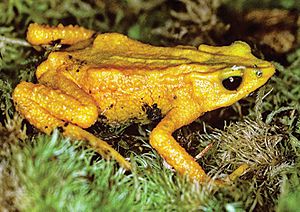Venezuelan yellow frog facts for kids
Quick facts for kids Venezuelan yellow frog |
|
|---|---|
 |
|
| Conservation status | |
| Scientific classification | |
| Synonyms | |
|
Atelopus oxyrhynchus carbonerensis Rivero, 1974 "1972" |
The Atelopus carbonerensis, also known as the Venezuelan yellow frog, is a type of toad. It belongs to the Bufonidae family. This special frog lived only in the Mérida Andes mountains of Venezuela.
Scientists last saw this frog in 1998. It is now thought to be extinct, meaning it no longer exists. If any are left, their numbers are extremely small.
What Did It Look Like?
Adult male Venezuelan yellow frogs were about 40 to 46 millimeters (1.6 to 1.8 inches) long. Female frogs were a bit bigger, measuring 44 to 55 millimeters (1.7 to 2.2 inches) long. This measurement is from their snout (nose) to their vent (bottom).
Their snout stuck out a bit. Their back legs were long. The frog's back was bright yellow. It had brown spots around its nostrils and sometimes on other parts of its body. The front part of its belly was a bright scarlet red. It also had small bumps, called tubercles, in rows along its back and some scattered here and there.
Where Did It Live?
The Venezuelan yellow frog lived in cloud forests. These forests are high up in the mountains, between 2,000 and 2,800 meters (about 6,560 to 9,180 feet) above sea level.
These frogs were found near streams. This is because their tadpoles (baby frogs) grew and developed in the water of these streams.
Why Did It Disappear?
This frog used to be very common. But in the 1980s, its numbers dropped very quickly. The last time anyone officially saw one was in 1998. Some people think they might have seen them later, but scientists have searched and not found any new ones.
The main reason for their disappearance is likely a disease called chytridiomycosis. This is a serious fungal disease that affects amphibians. Other problems also contributed, especially habitat loss. Much of the original cloud forest where they lived has been destroyed.
Part of the area where this frog lived is inside the Sierra La Culata National Park. This park helps protect the natural environment.
See also
 In Spanish: Ranita amarilla de la carbonera para niños
In Spanish: Ranita amarilla de la carbonera para niños


